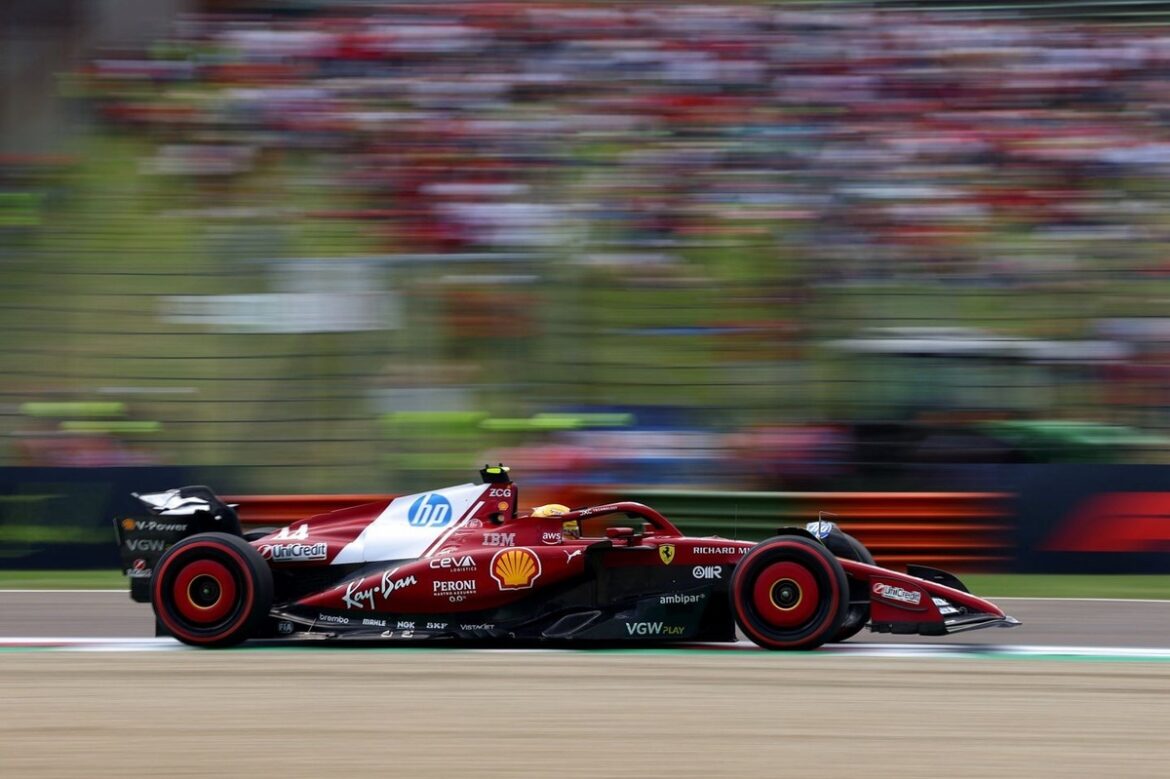Ferrari’s Struggles at Imola: A Closer Look at the Emilia-Romagna Grand Prix
The Emilia-Romagna Grand Prix at the historic Autodromo Enzo e Dino Ferrari has long been a highlight of the Formula 1 calendar. However, this year proved to be a particularly challenging one for the Scuderia Ferrari team. Both Charles Leclerc and Lewis Hamilton faced significant difficulties during qualifying, marking a disappointing chapter in Ferrari’s storied history at Imola.
Following qualifying, Charles Leclerc expressed his frustration candidly to a Sky Sports F1 microphone, commenting on the team’s performance. He lamented, “We are just P nowhere at the moment,” highlighting Ferrari’s struggles as they qualified in 11th and 12th positions, respectively. This result was notably the worst qualifying performance for Ferrari at Imola since the venue became a fixture on the F1 calendar back in 1980. Both drivers being eliminated in Q2 was a stark reminder of the team’s current struggles, especially given that Ferrari has historically been competitive at this track.
The Imola circuit, known for its challenging layout and passionate fanbase, has been a venue where Ferrari has traditionally thrived. In the past, the team has celebrated numerous successes, with legendary drivers like Gilles Villeneuve and Alain Prost making their marks on this iconic track. However, this year’s qualifying session was a far cry from those glorious memories. The 2023 Emilia-Romagna Grand Prix highlighted a worrying trend for Ferrari, showcasing their struggles to find the necessary speed and performance to compete effectively.
During the practice sessions leading up to qualifying, both Leclerc and Hamilton reported experiencing brake issues. Though these problems seemed somewhat alleviated by Saturday, the SF-25 car evidently reached its performance limits concerning the unique demands of the Imola circuit. The challenges became even more pronounced during the crucial Q2 sessions, where both Ferrari drivers lost valuable time in the slower corners.
Leclerc’s lap times reflected a concerning trend, particularly at the exit of the Variante Alta, where he struggled to maintain speed after experiencing understeer. Analyzing the data from these laps compared to competitors like Alex Albon from Williams revealed a striking discrepancy in cornering speed. At the Villeneuve right-hander, for instance, the Ferrari drivers were clocked at a staggering 12 km/h slower than their rivals, indicating a significant loss of time that ultimately cost them a shot at the top 10.
Hamilton echoed Leclerc’s sentiments after qualifying, expressing his own disappointment. “I feel super gutted, devastated that we weren’t able to get through,” he said. Despite feeling that the car had shown signs of improvement, with better brake performance and balance, the second run in Q2 proved to be slower than his first attempt. The inability to switch on the softest Pirelli tires when others managed to do so raises concerns about the car’s setup, especially given that other teams faced entirely different challenges with tire management.
While teams like Aston Martin successfully utilized medium tires to secure strong grid positions, Ferrari struggled to find the right setup that would allow them to maximize their potential. Leclerc remarked that achieving competitive lap times seemed unattainable for the Scuderia, indicating a deep-rooted issue with the SF-25’s performance capabilities. The team is set to introduce an upgrade package for the upcoming Spanish Grand Prix. However, both drivers are acutely aware that this upgrade must make a significant impact to alter their trajectory for the remainder of the season.
The narrative surrounding Ferrari’s performance isn’t just about one race or a single qualifying session; it’s about a broader trend that has persisted over multiple seasons. Despite the team’s efforts to improve the car’s performance, they have frequently found that upgrades have not been as transformative as anticipated. The challenge lies not only in finding speed but also in ensuring that the car behaves consistently for both drivers. This inconsistency can lead to a lack of confidence and hinder overall performance.
As the team looks ahead, the pressure to turn things around mounts. Leclerc’s candid acknowledgment that he cannot perform miracles with the current car reflects the frustration shared by fans and team members alike. The hopes for the upcoming upgrades are high, but the reality of the situation is that Ferrari must confront its limitations head-on if it wishes to reclaim its status as a competitive force in Formula 1.
In the days leading up to the race weekend, the atmosphere within the Ferrari team was one of cautious optimism. There was a palpable sense of anticipation regarding the potential for improvement and the hope that the car’s performance would align with the drivers’ expectations. However, that optimism quickly dissipated during qualifying as the reality of the situation set in.
The road ahead for Ferrari is fraught with challenges, and the pressure to deliver results is palpable. With the Spanish Grand Prix on the horizon, the team’s engineers and strategists are undoubtedly working around the clock to ensure that the upcoming upgrades will have the desired effect. The historical significance of Ferrari in the sport makes their current struggles all the more poignant, as fans and stakeholders eagerly await a resurgence.
As the team assesses its performance, there will inevitably be discussions about the design philosophy behind the SF-25, tire management strategies, and the overall approach to race setups. The balance between speed and tire degradation is a critical factor in Formula 1, and teams must navigate this landscape carefully to maximize their potential.
In conclusion, the Emilia-Romagna Grand Prix served as a stark reminder of the challenges facing Ferrari. The team’s struggles during qualifying, coupled with the ongoing quest for performance improvements, underscore the difficulties inherent in modern Formula 1 racing. As they look toward the future, Ferrari must harness its resources, learn from its setbacks, and strive to elevate its performance on the track. The journey ahead will require resilience and determination as the team aims to reclaim its position among the elite in Formula 1.
